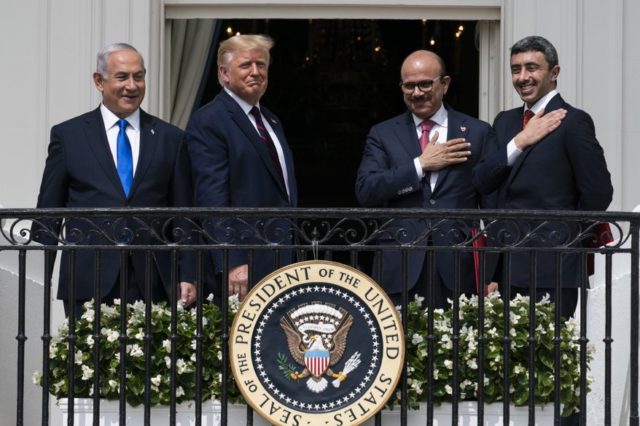Think of Iran as a lobster body with two pincer arms.
The north pincer is commonly referred to as the “Shiite Crescent,” stretching from the body across Iraq, Syria and Lebanon to the Mediterranean Sea. It is both a “lid” on Iran’s primary enemies Saudi Arabia, Jordan and Israel and a wedge between Sunni Turkey and the Sunni Arab States. The southern pincer stretches from the body through the Persian Gulf and under the Arabian Peninsula with a Houthi-led war on the Saudis from Yemen in the heel of the boot, and from there stretching Iran’s influence up the Red Sea along the coasts of Saudi Arabia, Jordan, Israel, Egypt, Sudan, Eritrea and Somalia. And about 18 miles across the Bab el-Mandeb Straits from the U.S. base in Djibouti.
Attention has been rightly and happily focused on the Abraham Accord agreements between Israel, Bahrain and the United Arab Emirates witnessed by the United States and openly encouraged by other Gulf States and Arab countries. But those changes in the politics of the southern pincer make Iran more desperate and more determined to control the northern one.
But not without pushback. From someone.
Thursday brought (another) video of an explosion in Iran, said to be at the Padideh chemical company in the Eshtehard Industrial Zone in Karaj, west of Tehran. It follows a series of explosions including what locals in Qeshm Island said was an ammunition dump (the government said it was an earthquake); a power station at Isfahan; the Tondgooyan petrochemical plant; a gas storage tank complex near Mashhad; and, of course at the Natanz nuclear facility.
And Iran’s position along the northern pincer is being eroded.
Syria is a crucial piece, allowing Iran to reach its ally Hezbollah in Lebanon over land. At least three major airstrikes aimed at Iranian facilities in Syria occurred in September. The last effectively eliminated a missile production facility outside Aleppo, completely destroying one building and damaging another.
Israel doesn’t comment on things blowing up in either Iran or Syria, but acknowledges three red lines: no Iranian or Hezbollah bases near the Israeli border; no weapons that Israel considers “situation-changing” delivered by Iran to Hezbollah; and no use of non-conventional weapons.
It has carefully and consistently maintained those lines while staying out of the civil war. The Trump administration helped by punishing Syria for its use of chemical weapons, and Russia has been willing to deconflict with the Israeli Air Force.
After nine years of war, with more than half a million Syrians dead and half the population displaced, the Assad government appears to have survived, hanging onto about half of its former territory. But the part Assad does not control contains oil and fertile cropland, both of which helped fill the treasury in Damascus and now do not. The Kurds control a large swath of the northeast and a bit near Afrin, with Turkey periodically roiling the region. The ISIS territorial caliphate is gone but ISIS remains a factor in the area and elsewhere. The situation is a low-scale but deadly wreck.
Iran spent an estimated $16 billion in Syria as of late 2018 to entrench itself, at one point managing a militia of about 80,000 troops. The money was part of the windfall from the Obama administration and enhanced trade with Europe. In 2020, the windfall is gone, sanctions are biting and even where Iran does sell oil, the price is much reduced. The Iranians no longer have the funds to pay for more fighting or for the reconstruction the Syrian people need.
In principle, Moscow thinks Iranian-backed forces should leave, but with its naval and air forces safely along the Assad-controlled coast, it will put neither military nor political muscle toward that end. Neither, though, will it help Iran protect its investment.
Iraq, another crucial part of the pincer, is rebelling against Iranian pressure and Iran’s theft of Iraqi oil to sell in violation of sanctions. Ongoing riots in the southern part of Iraq the Shiite areas were only briefly curtailed by the pandemic. Anti-Hezbollah riots in Lebanon began long before the explosion that destroyed the Beirut harbor, and continue now. No one has taken credit/blame for last week’s huge explosion at a Hezbollah arms depot in southern Lebanon, but no one has to.
Back at home, the Iranian people’s uprising that began in 2017 continues with the added stress of President Trump’s snapback sanctions and the COVID-19 dislocations.
And now, the Gulf States, including those that have not signed treaties, plus Egypt and Jordan, are working with Israel.
Iran faces disruption of its plan for regional domination along both legs of the pincer, which qualifies as rare good news on the Iran front.


